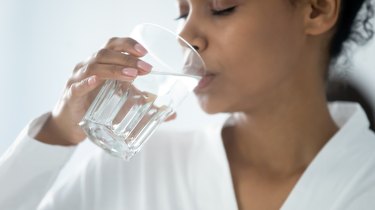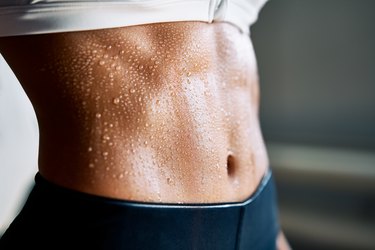
While everyone sweats a little differently, a few people have a rare condition called anhidrosis that prevents them from sweating at all. While this may seem like a blessing to some, it can be dangerous and potentially life-threatening.
"Sweating is important. It is how your body cools down when approaching high temperatures," says Eric Ascher, DO, a family physician at Lenox Hill Hospital in New York City. "Without sweating, your body cannot reach a stable temperature and has the potential to overheat."
Video of the Day
Video of the Day
This can lead to heat exhaustion, heat stroke and even death.
Here, we'll take a look at what causes anhidrosis, its symptoms, and how the condition is diagnosed and treated.
What Is Anhidrosis?
Put simply, anhidrosis is when you don't sweat.
Normally, our autonomic nervous system triggers our eccrine sweat glands (the ones on the skin) to sweat whenever body temperature rises. As the sweat evaporates on your skin, your body cools down. According to the International Hyperhidrosis Society, a single bead of sweat can cool one quart of blood by 1 degree Fahrenheit.
With anhidrosis (sometimes called hypohidrosis), your sweat glands don't produce sweat in the expected situations — think: extreme heat, when you're nervous or during exercise, Dr. Ascher says.
Anhidrosis is most severe when it affects your whole body. Often, though, it involves smaller areas or patchwork pieces of the body and may not even be noticeable, says Heidi Prather, MD, a member of the American Academy of Dermatology who practices with Westlake Dermatology in Austin, Texas.
Causes of Anhidrosis
Skin conditions like psoriasis that block the sweat ducts are the most common cause of anhidrosis, according to the International Hyperhidrosis Society.
If you don't have a skin condition and still don't sweat, one of these causes may be to blame, per the Cleveland Clinic:
- Skin injuries from burns or radiation therapy
- Sweat-gland damage from surgery or injuries
- Genetic conditions like Fabry disease (when lipids build up and impair the autonomic nervous system) and ectodermal dysplasias, when a person is born with sweat-gland defects (as well as defects to the hair, nails and teeth).
- Certain autoimmune conditions and connective-tissue diseases like Sjogren's disease or lupus
- Nerve damage from diabetes, gout, alcoholism or Guillain-Barre Syndrome
- Parkinson's disease, stroke and other diseases that affect the central nervous system
- Horner's syndrome, a form of nerve damage to the eyes with a multitude of possible causes, from snake bites to neck injury (anhidrosis on the face is one symptom)
- In addition to being a complication of anhidrosis, hyperthermia (when your body overheats) can cause anhidrosis
- Dehydration
Drugs that can cause anhidrosis include:
- Morphine and other opioids
- Botulinum toxin type A
- Anti-psychotics such as Clozaril (clozapine) and quetiapine (Seroquel)
- Tricyclic antidepressants such as amitriptyline
- Antihistamines like diphenhydramine (Benadryl)
- Anticholinergics like doxepin (Silenor) or atropine (Atropen)
- Antiseizure medications like topiramate (Topamax)
- Calcium channel blockers like Amlodipine (Norvasc), which treat high blood pressure
We don't know exactly how common anhidrosis is, likely because many cases are mild and go unreported, per the Cleveland Clinic.
Symptoms of Anhidrosis
Anhidrosis or lack of sweating is a symptom unto itself. If you don't sweat, it's likely to be most noticeable in hot weather, while you're exercising or under other conditions when sweat would be expected.
It is also possible to have anhidrosis on one part of your body, like your face, but not elsewhere.
Anhidrosis may also involve the following symptoms, according to the Cleveland Clinic:
- Feeling flushed, dizzy or hot
- Having muscle cramps or weakness
Signs of heat exhaustion, one possible complication of anhidrosis, include not just weakness but also nausea and a racing pulse.
Warning
If you have red, hot, dry skin along with confusion, you may have heatstroke, a life-threatening condition that happens when your body reaches 103 degrees Fahrenheit or more. If you experience these symptoms, get medical attention right away.
Diagnosing Anhidrosis
The first step on the journey toward treating or managing anhidrosis is getting the correct diagnosis, Dr. Prather says. Typically, when you notice that you don't sweat, you'll see a dermatologist, who might then refer you to a neurologist or another specialist for treatment.
The doctor will likely start with questions about sweating and your daily habits along with getting a family and personal medical history, including any medications you're taking, says Dr. Ascher.
They may also do a sweat test: "Your doctor will apply powder to your body and watch how your body reacts when sweating," Dr. Ascher explains.
There are also nerve tests to look for nerve damage and genetic testing, if needed.
Treating Anhidrosis
Anhidrosis that affects only small portions of your body may not need treatment, per the National Library of Medicine. Treatment for more generalized anhidrosis often depends on what's causing it and can be hard to manage.
"The cause will determine treatment," says Dr. Ascher. "If it's related to a medication, your doctor will likely alter the dose or medication entirely. If it's related to an uncontrolled disease like diabetes, your doctor may suggest a tighter diet or additional medications. If it's related to thyroid disease, medications may be encouraged."
If no cause is found (called idiopathic anhidrosis) and you have a mild case, your doctor may suggest avoiding activities that put you at risk for being unable to cool your body down and to follow this advice:
- Avoid hot environments and stay inside on hot days
- Don't overexert yourself
- Wear loose-fitting clothes and a wide-brimmed hat
- Have a spray bottle with water handy to cool yourself down
- Stay hydrated with plenty of fluids
"Most people are not as bothered [by anhidrosis] as they might be with profuse sweating," adds Dr. Prather. But: "When anhidrosis starts to affect the ability to regulate body temperature, more aggressive treatment is necessary."
When to See a Doctor
Get medical help "when your body temperature is above 100.4, you have no symptoms of a cold or flu and you are not sweating," advises Dr. Ascher. "If you feel moments of confusion, joint pains and thirst, and note a high body temperature, it is important to seek immediate attention as this can be related to heat stroke, which is life-threatening."
- Mayo Clinic: “Anhidrosis”
- Cleveland Clinic: “Anhidrosis (Lack of Sweat)”
- International Hyperhidrosis Society: “Anhidrosis (Inability to sweat)”
- StatPearls: “Anhidrosis”
- U.S. National Library of Medicine: “Absence of sweating”
- National Cancer Institute: “Anhidrosis”
- National Institute of Neurological Disorders and Stroke: “Fabry Disease Information Page”
- National Foundation for Ectodermal Dysplasias: “What Are Ectodermal Dysplasias?”
- National Organization of Rare Diseases: “Horner’s Syndrome”
Is this an emergency? If you are experiencing serious medical symptoms, please see the National Library of Medicine’s list of signs you need emergency medical attention or call 911.


